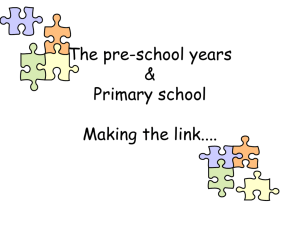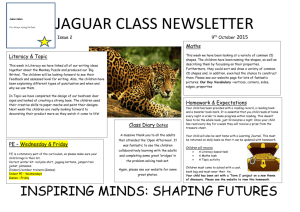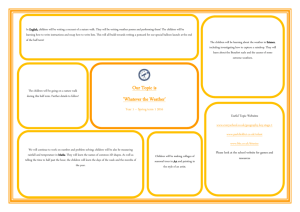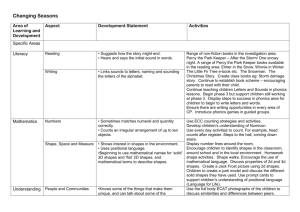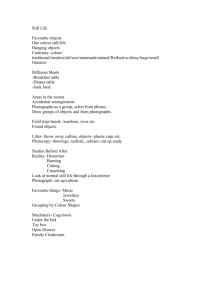Primary Children - Oxford Health NHS Foundation Trust
advertisement
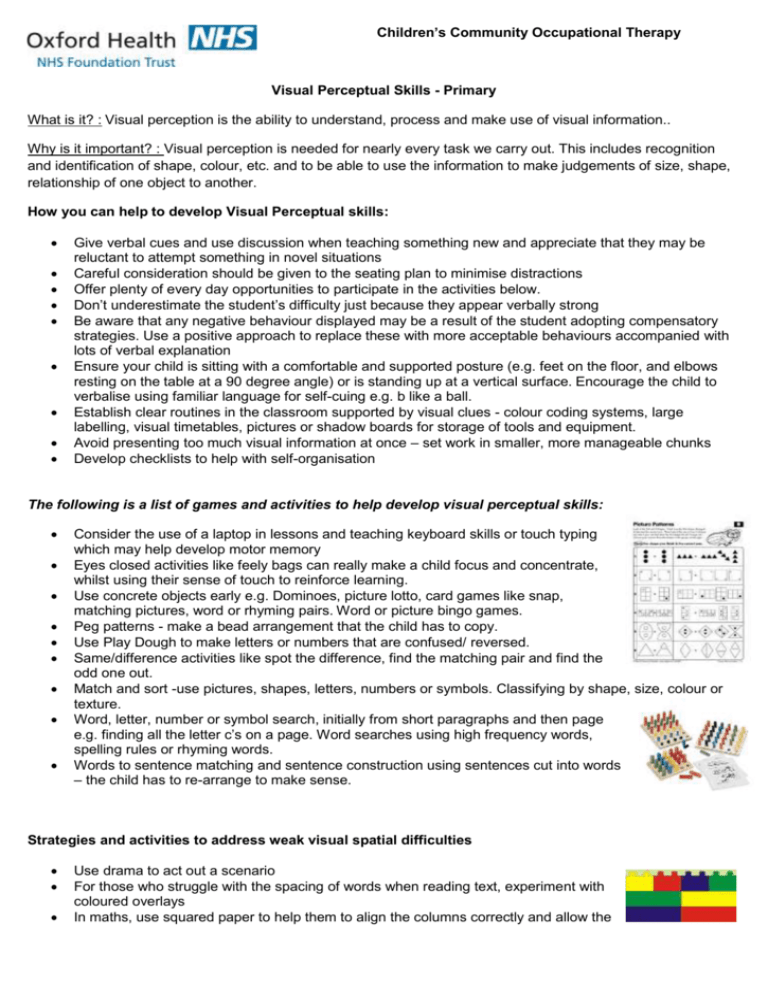
Children’s Community Occupational Therapy Visual Perceptual Skills - Primary What is it? : Visual perception is the ability to understand, process and make use of visual information.. Why is it important? : Visual perception is needed for nearly every task we carry out. This includes recognition and identification of shape, colour, etc. and to be able to use the information to make judgements of size, shape, relationship of one object to another. How you can help to develop Visual Perceptual skills: Give verbal cues and use discussion when teaching something new and appreciate that they may be reluctant to attempt something in novel situations Careful consideration should be given to the seating plan to minimise distractions Offer plenty of every day opportunities to participate in the activities below. Don’t underestimate the student’s difficulty just because they appear verbally strong Be aware that any negative behaviour displayed may be a result of the student adopting compensatory strategies. Use a positive approach to replace these with more acceptable behaviours accompanied with lots of verbal explanation Ensure your child is sitting with a comfortable and supported posture (e.g. feet on the floor, and elbows resting on the table at a 90 degree angle) or is standing up at a vertical surface. Encourage the child to verbalise using familiar language for self-cuing e.g. b like a ball. Establish clear routines in the classroom supported by visual clues - colour coding systems, large labelling, visual timetables, pictures or shadow boards for storage of tools and equipment. Avoid presenting too much visual information at once – set work in smaller, more manageable chunks Develop checklists to help with self-organisation The following is a list of games and activities to help develop visual perceptual skills: Consider the use of a laptop in lessons and teaching keyboard skills or touch typing which may help develop motor memory Eyes closed activities like feely bags can really make a child focus and concentrate, whilst using their sense of touch to reinforce learning. Use concrete objects early e.g. Dominoes, picture lotto, card games like snap, matching pictures, word or rhyming pairs. Word or picture bingo games. Peg patterns - make a bead arrangement that the child has to copy. Use Play Dough to make letters or numbers that are confused/ reversed. Same/difference activities like spot the difference, find the matching pair and find the odd one out. Match and sort -use pictures, shapes, letters, numbers or symbols. Classifying by shape, size, colour or texture. Word, letter, number or symbol search, initially from short paragraphs and then page e.g. finding all the letter c’s on a page. Word searches using high frequency words, spelling rules or rhyming words. Words to sentence matching and sentence construction using sentences cut into words – the child has to re-arrange to make sense. Strategies and activities to address weak visual spatial difficulties Use drama to act out a scenario For those who struggle with the spacing of words when reading text, experiment with coloured overlays In maths, use squared paper to help them to align the columns correctly and allow the use of a calculator where possible, highlight or colour code the function symbols (add/minus/multiplied) or make them bigger When completing a formula in maths, number the different steps in the order in which they are carried out and give a clear example to refer to Put markers at the beginning of the lines to identify a starting point Provide prepared worksheets to minimise writing and where possible, let them take notes or submit work in the form of bullet points or spider diagrams A child with visual spatial difficulties may not be able to ‘read between the lines’ and fail to interpret information that is obvious to the rest of the class Decoding secret messages – present a sentence correctly spelt but with the spaces moved so that visually is doesn’t make sense e.g. I love boiled eggs becomes – Ilo vebo ile deg gs Copying patterns/pictures with shapes that addresses both visual spatial and fine motor skills Present half of a picture for them to complete the other half Sewing or threading activities – can link to letter/number/shapes or spelling rules Make 3d models out of a 2d drawing – but keep it simple Strategies and activities to address weak visual form constancy Using concrete items - do lots of sorting and matching activities categorising according to colour, size, shape or types, such as items in a pencil case – sort out all the pens from the pencils, then categorise further within those groups, putting them in groups according to colour or size Examine items within the same category that are not an exact visual match – gather up lots of different kinds of spoons such as teaspoons, tablespoons, wooden spoons and plastic spoons etc. Play ‘I spy’ with everyday objects around the room to identify those with similar forms, such as everything circular – clock, table, bowl etc. Match the shadow Origami and puzzles Explore how objects look from different angles – from above, behind, underneath Make a piece of card with a small hole cut out of it and place it over a picture so that the picture is hidden except for the area visible through the hole. Ask the child to guess what the picture is Cut out shapes varying in colour and size. Hold one up and ask the child to point to something that is the same shape Present some photographs or pictures of a person or character taken from different angles and see if they can recognise the person/character – can use photographs of family members or pictures of pop/TV stars Ask the child to identify shapes, letters, numbers or symbols drawn on the back with a finger Closed eye/feely bag activities Making shapes out of straws or pipe cleaners Strategies and activities to address weak visual figure ground Use reading markers – square cut out in the middle of a card When looking for an object in a bag or cupboard, teach how to visualise that object or look for distinguishing features e.g. a DVD is rectangular and flat Crosswords/quiz words and Sudoku Colouring by numbers Bingo and other board games Making/copying patterns Word/letter/number/symbol search on a busy page Scanning tracking activities – circling the same word in a text Odd one out pictures Overlapping figures – trace the outline of a particular shape Find a fairly detailed picture and ask the child to find specific objects in that picture e.g. an underwater picture – ask the child to find all the blue fish or all the striped fish Strategies and activities to address weak visual closure Provide a template containing key words and information When completing a formula in maths, number the different steps in the order in which they are carried out and give clear examples to refer to In maths – use concrete objects where possible and provide templates for drawing shapes, graphs and charts Use bullet points or spider diagrams as prompts to get their ideas down on paper, which they can then build upon and develop further In art, textiles and design and technology, have an example of the finished product on hand, to help visualise the end result Say half a sentence to them and ask them to complete it. Can vary it by using rhyme – the cat sat on the ______ ? Give them a complete sentence but with the last letter missing in some of the words and they have to fill them in e.g. after dinne you can have an ice-crea Complete pictures in which only parts of objects/shapes are revealed. “What is missing” worksheets or spot the difference Dot-to-dot activities Building three-dimensional models from cubes, cylinders, and blocks Connect broken lines to complete a shape or form. Partially cover an object or shapes and have the child identify it. Draw only half a number, letter or picture and ask the child to match it to a completed version. Make ‘peephole’ pictures – cover a picture with a piece of paper with a small hole cut out of it – the child tells you what they think it is
